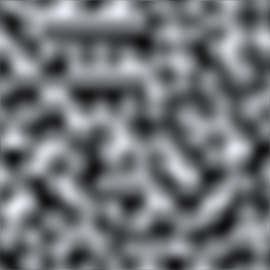public static function PerlinNoise(x:
float,
y: float):
float;
public static float PerlinNoise(float x,
float y);
パラメーター
| x | サンプル点の X 座標 |
| y | サンプル点の Y 座標 |
戻り値
float 0.0 と 1.0 の間の値
説明
2D のパーリンノイズを生成します
パーリンノイズは 2D 平面で生成される浮動小数点値の擬似ランダムパターンです
( 3D 以上では一般的なテクニックですが Unity には実装されていません)。
ノイズは各点で完全にランダムな値を含んでいませんが、
むしろ値が徐々に増加し、パターンの間で減少する "波"で構成されています。ノイズは
テクスチャエフェクトのための基礎として使用できますが、アニメーションやテラインハイトマップや
その他多くのものを生成するためのものでもあります。
" 0 から 10 の範囲でサンプリングされるパーリンノイズ (グレースケールの値は 0 から 1 の値で表されます) ”
平面上に任意の点をサンプリングするために適切な X と Y 座標を渡します。
同じ座標には常に同じサンプリング値を返しますが、平面は
本質的に無限ですので、サンプルのエリアをランダムに選択することによって、簡単に繰り返しを避けられます。
// Create a texture and fill it with Perlin noise. // Try varying the xOrg, yOrg and scale values in the inspector // while in Play mode to see the effect they have on the noise.
// Width and height of the texture in pixels. var pixWidth: int; var pixHeight: int;
// The origin of the sampled area in the plane. var xOrg: float; var yOrg: float;
// The number of cycles of the basic noise pattern that are repeated // over the width and height of the texture. var scale = 1.0;
private var noiseTex: Texture2D; private var pix: Color[]; private var rend: Renderer;
function Start () { rend = GetComponent.<Renderer>(); // Set up the texture and a Color array to hold pixels during processing. noiseTex = new Texture2D(pixWidth, pixHeight); pix = new Color[noiseTex.width * noiseTex.height]; rend.material.mainTexture = noiseTex; }
function CalcNoise() { // For each pixel in the texture... for (var y = 0.0; y < noiseTex.height; y++) { for (var x = 0.0; x < noiseTex.width; x++) { // Get a sample from the corresponding position in the noise plane // and create a greyscale pixel from it. var xCoord = xOrg + x / noiseTex.width * scale; var yCoord = yOrg + y / noiseTex.height * scale; var sample = Mathf.PerlinNoise(xCoord, yCoord); pix[y * noiseTex.width + x] = new Color(sample, sample, sample); } } // Copy the pixel data to the texture and load it into the GPU. noiseTex.SetPixels(pix); noiseTex.Apply(); }
function Update () { CalcNoise(); }
using UnityEngine; using System.Collections;
public class ExampleClass : MonoBehaviour { public int pixWidth; public int pixHeight; public float xOrg; public float yOrg; public float scale = 1.0F; private Texture2D noiseTex; private Color[] pix; private Renderer rend; void Start() { rend = GetComponent<Renderer>(); noiseTex = new Texture2D(pixWidth, pixHeight); pix = new Color[noiseTex.width * noiseTex.height]; rend.material.mainTexture = noiseTex; } void CalcNoise() { float y = 0.0F; while (y < noiseTex.height) { float x = 0.0F; while (x < noiseTex.width) { float xCoord = xOrg + x / noiseTex.width * scale; float yCoord = yOrg + y / noiseTex.height * scale; float sample = Mathf.PerlinNoise(xCoord, yCoord); pix[y * noiseTex.width + x] = new Color(sample, sample, sample); x++; } y++; } noiseTex.SetPixels(pix); noiseTex.Apply(); } void Update() { CalcNoise(); } }
ノイズ面は 2D ですが、アニメーション効果のパターンを通してひとつの 1 次元の線を使うことは簡単です。
// "Bobbing" animation from 1D Perlin noise. // Range over which height varies. var heightScale = 1.0; // Distance covered per second along X axis of Perlin plane. var xScale = 1.0; function Update () { var height = heightScale * Mathf.PerlinNoise(Time.time * xScale, 0.0); var pos = transform.position; pos.y = height; transform.position = pos; }
using UnityEngine; using System.Collections;
public class ExampleClass : MonoBehaviour { public float heightScale = 1.0F; public float xScale = 1.0F; void Update() { float height = heightScale * Mathf.PerlinNoise(Time.time * xScale, 0.0F); Vector3 pos = transform.position; pos.y = height; transform.position = pos; } }
注意: 戻り値が少しだけ 1.0f を超えることもできます。 0.0 から 1.0 の範囲が重要な場合、戻り値を固定する必要があります。